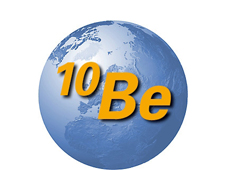Exposure Dating
Cosmogenic nuclides are created through the collision of cosmic rays with atomic nuclei. These nuclei can be atmospheric (e.g. nitrogen, oxygen) or terrestrial. Rock surface dating (surface exposure dating) relies on terrestrially formed nuclides and soil dating relies on atmospherically formed nuclides.
Surface exposure dating with cosmogenic nuclides
Cosmic rays impinge on an exposed rock surface and induce nuclear reactions with the nucleus of the minerals and create “cosmogenic isotopes”, one of them being 10Be. The concentration of these isotopes is measured by accelerator mass spectrometry (AMS) and gives a direct measure of the exposure time of the rock surface.
Since the method’s introduction it has been applied to study more and more specific questions in earth sciences and within different geomorphic contexts. The method has contributed to a significant improvement in the chronology of late-würmian and Holocene glacier fluctuations.
Soil dating with cosmogenic nuclides
Meteoric Beryllium is formed in the atmosphere and infiltrates into soils by precipitation where it is adsorbed by the upper permeable layers of soil.
